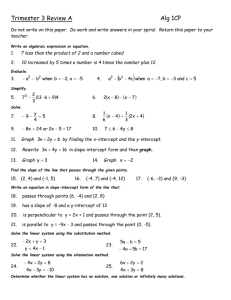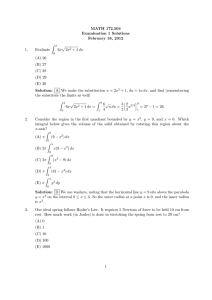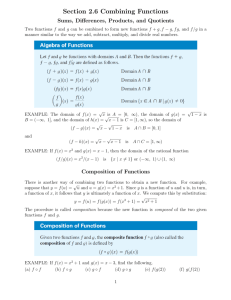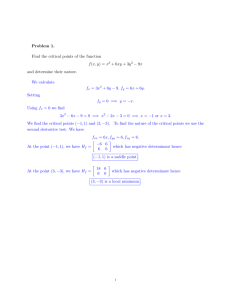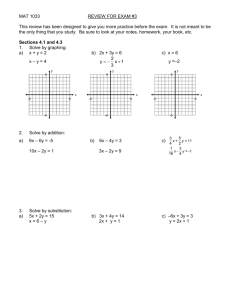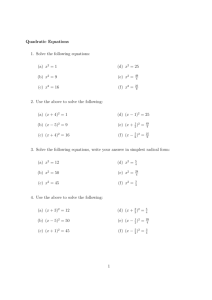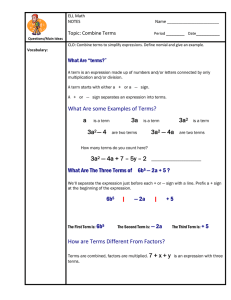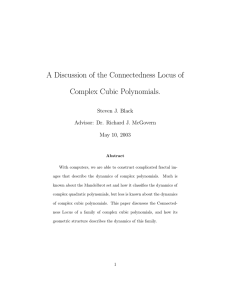Determine the domain of a function
advertisement
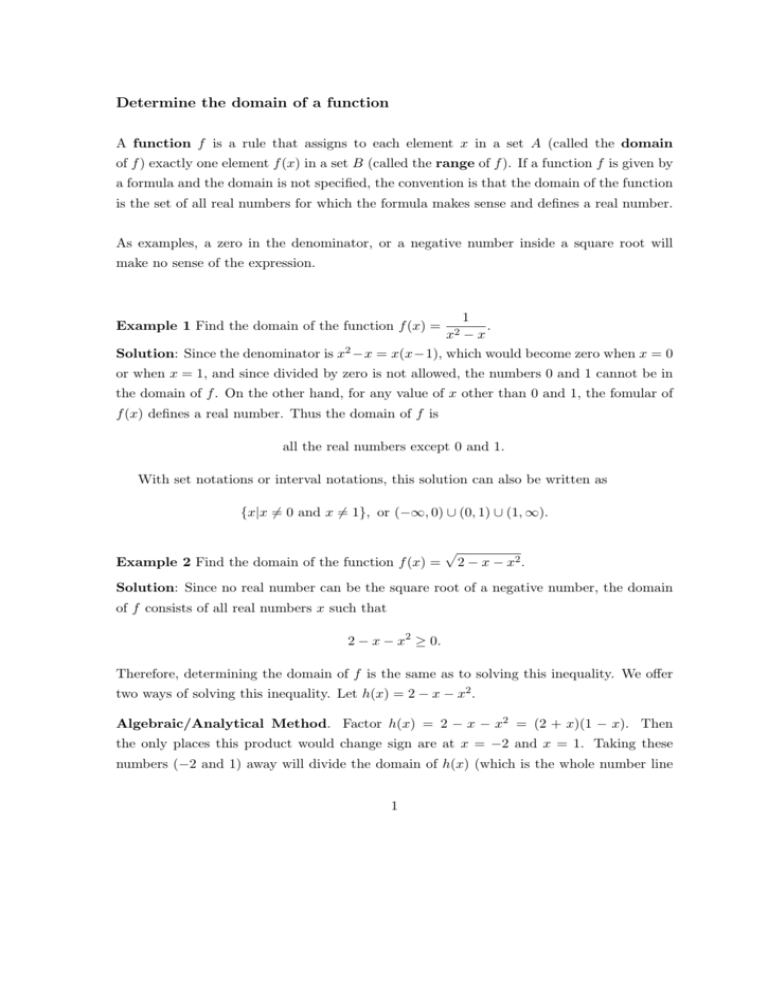
Determine the domain of a function
A function f is a rule that assigns to each element x in a set A (called the domain
of f ) exactly one element f (x) in a set B (called the range of f ). If a function f is given by
a formula and the domain is not specified, the convention is that the domain of the function
is the set of all real numbers for which the formula makes sense and defines a real number.
As examples, a zero in the denominator, or a negative number inside a square root will
make no sense of the expression.
1
.
x2 − x
Solution: Since the denominator is x2 −x = x(x−1), which would become zero when x = 0
Example 1 Find the domain of the function f (x) =
or when x = 1, and since divided by zero is not allowed, the numbers 0 and 1 cannot be in
the domain of f . On the other hand, for any value of x other than 0 and 1, the fomular of
f (x) defines a real number. Thus the domain of f is
all the real numbers except 0 and 1.
With set notations or interval notations, this solution can also be written as
{x|x 6= 0 and x 6= 1}, or (−∞, 0) ∪ (0, 1) ∪ (1, ∞).
Example 2 Find the domain of the function f (x) =
p
2 − x − x2 .
Solution: Since no real number can be the square root of a negative number, the domain
of f consists of all real numbers x such that
2 − x − x2 ≥ 0.
Therefore, determining the domain of f is the same as to solving this inequality. We offer
two ways of solving this inequality. Let h(x) = 2 − x − x2 .
Algebraic/Analytical Method. Factor h(x) = 2 − x − x2 = (2 + x)(1 − x). Then
the only places this product would change sign are at x = −2 and x = 1. Taking these
numbers (−2 and 1) away will divide the domain of h(x) (which is the whole number line
1
(−∞, ∞)) into three intervals, names (−∞, −2), (−2, 1) and (1, ∞). Pick a number in each
of these intervals (say, −3 in the first, 0 in the second and 2 in the third) will reveal that the
function h(x) will be negative in the intervals (−∞, −2) and (1, ∞) (since h(−3) = −4 < 0
√
and h(2) = −4 < 0), and h(x) is positive in (−2, 1) (since h(0) = 2 > 0). Note that 0 = 0,
and so x = −2 or x = 1 would also make f (x) meaningful. Therefore, the domain of f is
all the real numbers in the closed interval [−2, 1].
Graphic Method (Please note that this method works fine for quadratic functions, and
make not work well for other functions).
Sketch the graph of the parabola y = h(x) = 2−x−x2 . Since 2−x−x2 = (2+x)(1−x),
the graph crosses the x-axis at x = −2 and x = 1. Since the opening of the parabola is
downward, the portion of the parabola which is above and on the x-axis (which is the same
as h(x) ≥ 0) will be over the interval [−2, 1]. Therefore, we conclude that the domain of
f (x) is [−2, 1].
Evaluate a function
Example 1 Let f (x) = x2 + 5, and let a > 0 and h be real numbers. Find and simply
√
f (−a), f (a−1 ), f ( a), f (a + h).
Solution: Replace x in f (x) by the corresponding value/expression to get
f (−a) = (−a)2 + 5 = a2 + 5.
f (a−1 ) = (a−1 )2 + 5 = a−2 + 5 =
√
√
f ( a) = ( a)2 + 5 = a + 5.
1 + 5a2
.
a2
f (a + h) = (a + h)2 + 5 = a2 + 2ah + h2 + 5.
Example 2 Let g(x) = x3 − 3. Find all the values of a such that g(a) = 5.
Solution: Note that g(a) = a3 − 3. Then g(a) = 5 is equivalent to a3 − 3 = 5, or a3 = 8.
Therefore, a = 2.
Example 3 Let g(x) = 2x2 − x + 4. Find all the values of a such that g(a) = 5.
Solution: Note that g(a) = 2a2 − a + 4. Then g(a) = 5 is equivalent to 2a2 − a + 4 = 5, or
2
2a2 − a − 1 = 0. Factor the left side to get (2a + 1)(a − 1) = 0, and so, a = 1 and a = − 21 .
Example 3 Let g(x) = 3x2 + 4x + 7. Find and simply f (a + h) − f (a).
Solution: First compute f (a + h) = 3(a + h)2 + 4(a + h) + 7 = 3a2 + 6ah + 3h2 + 4a + 4h + 7.
Then compute f (a) = 3a2 + 4a + 7. A subtraction gives the answer:
f (a+h)−f (a) = 3a2 +6ah+3h2 +4a+4h+7−(3a2 +4a+7) = 6ah+3h3 +4h = h(6a+3h+4).
Evaluate composition functions
The composition of two functions f and g is the function h = f ◦ g defined by
h(x) = f (g(x)),
for all x in the domain of g such that g(x) is in the domain of f .
Example 1 If f (x) = x2 + 1 and g(x) =
x2
1
, find f (g(x)) and g(f (x)).
+1
Solution:
1
1
x4 + 2x2 + 3
+
1
=
+
1
=
(x2 + 1)2
x4 + 2x2 + 2
x4 + 2x2 + 2
1
1
1
= 2
= 4
.
(f (x))2 + 1
(x + 1)2 + 1
x + 2x2 + 2
f (g(x)) = (g(x))2 + 1 =
g(f (x)) =
Example 2 If f (x) = −7 and g(x) = |x|, find f (g(x)) and g(f (x)).
Solution:
f (g(x)) = −7
(the answer is independent of the input x)
g(f (x)) = |f (x)| = | − 7| = 7.
Example 3 If f (x) =
√
x and g(x) = cos x, find f (g(x)) and g(f (x)).
Solution:
q
√
cos x
(for those x such that cos x ≥ 0)
√
g(f (x)) = cos(f (x)) = cos x.
f (g(x)) =
g(x) =
3

